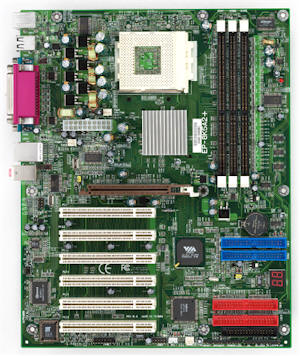|

Using a provided EPoX picture (the board differs slightly from this picture, I'll cover the differences as we come across them), let us take a look at the layout starting as always in the top left as you can see it and working across and down.
Starting in the very top left we come across the power regulation circuitry for the CPU socket. A pair of capacitor rows flank a rotated socket. We prefer a top to bottom socket rotation but I'm sure EPoX have their reasons for the orientation. The board easily passes the Swiftech MCX462 test so any hefty heatsink should fir without issue.
Past the socket over on the top right area of the board we come across the triplet of DDR DIMM slots that are happy with up to 3GB of PC2700 DDR (although of course the board supports a wide variety of DDR types from DDR2100 to PC3200 and beyond, PC2700 is what will see most use in this board). There is board space for the fourth DIMM slot that you'll find on the 8K5A3+ but no slot here. Past that PCB space we have the voltage circuitry for the DIMM banks and a DDR status LED.
Underneath the CPU regulation components we have a horizontally orientated ATX connector. It's not the most inspired placement for it but it's far enough left that hopefully dragging your ATX connector to the socket wont interfere with the CPU socket area and precious airflow around this area. It wasn't that much of a problem in my test chassis but it nonetheless could be sited elsewhere for better placement.
The northbridge heatsink differs on the supplied board from the one in the picture with a more solid centre section and a natty green EPoX logo on top. The sink in the picture is the same as on the 8K3A from memory but it's certainly different on my test board.
From northbridge down it's pretty much standard fare. The VIA Ethernet controller chip used sits close to the AGP4X slot (which supports fast writes and side band addressing via the KT333 bridge). 6 PCI gives you excellent expansion. IDE 1 and 2 (southbridge provided) sit alongside the VT8235. Here's a quick snap of the bridge, you can just about see the two blue coloured IDE ports to the right of it.

Underneath that bridge you'll find the Highpoint HPT372 RAID controller flanked on the right by the 2 red IDE ports it controls. All four IDE ports are horizontally oriented and I prefer them vertical but it's no huge issue. The floppy connector is all that's left underneath the RAID controller ports.
Lastly, we have the POST monitor display, a 2 digit hex readout in lovely red (someone put a blue one on, be daring!). The ATX case headers are well laid out and very well labelled and I didn't need to consult with the manual to set the board up.
|